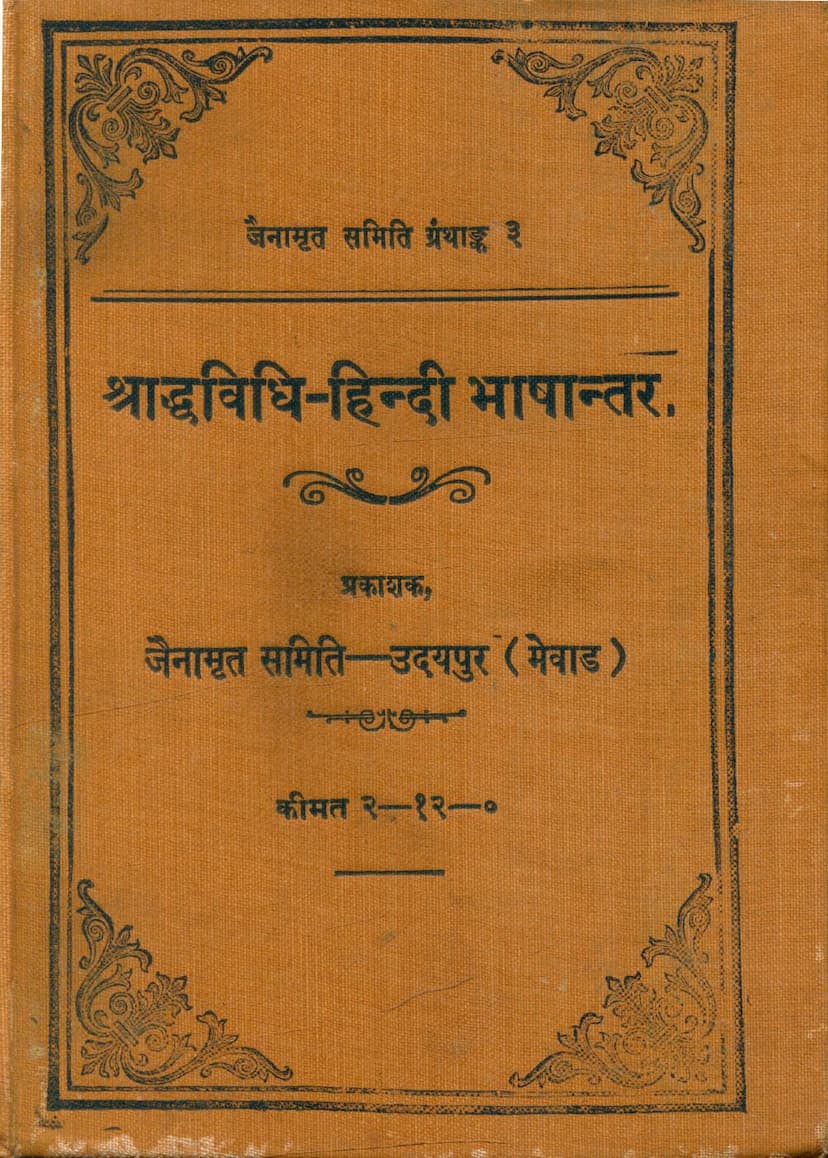Shraddh Vidhi Hindi Bhashantar
Added to library: September 2, 2025

Summary
Here is a comprehensive summary of the Jain text "Shraddh Vidhi Hindi Bhashantar" by Ratnashekharsuri:
Title: Shraddh Vidhi (A Manual for the Lay Follower) Author: Acharya Ratnashekharsuri Publisher: Jainamrut Samiti, Udaipur Language: Hindi Translation (originally in Prakrit/Sanskrit, with a commentary named Vidhi Kaumudi)
This book is a detailed guide for Jain lay followers (Shravaks and Shravikas) on how to conduct their daily lives according to Jain principles. It lays out the essential practices and ethical guidelines for maintaining a righteous and spiritual life as a householder.
Key Themes and Content:
The "Shraddh Vidhi" is structured as a comprehensive manual covering various aspects of a Jain layperson's life, encompassing daily rituals, ethical conduct, dietary restrictions, and spiritual observances. The text is divided into several "chapters" or "doors" (Dwar) that systematically guide the reader. Based on the detailed index provided, the book covers an extensive range of topics, including:
I. Introduction and Foundation:
- Mangalacharan (Invocation): Begins with prayers to the Panch Parameṣṭhis (Arhat, Siddha, Acharya, Upadhyaya, Muni) for auspiciousness.
- Purpose and Author's Intent: Explains the purpose of the book as a guide for lay followers, based on the teachings of Lord Mahavir.
- Qualities of a Suitable Follower: Outlines the characteristics of an individual fit to embrace the lay follower's path, emphasizing qualities like good nature, discerning intellect, adherence to justice, and steadfastness in vows.
- The Twenty-One Virtues of a Shravak: Elaborates on the essential qualities and virtues that a lay follower should cultivate, such as generosity, pleasant appearance, equanimity, compassion, courage, honesty, modesty, contentment, and adherence to truth.
II. Daily and Nightly Regimen (Dinacharya & Ratricharya):
- Waking and Morning Rituals: Details the proper time to wake up, the importance of Brahmamuhurta, and the initial activities like contemplation and reciting the Navkar Mantra.
- Hygiene and Purity: Explains the procedures for brushing teeth (using an appropriate twig), cleansing the mouth, and the significance of bathing (both external and internal).
- Navkar Mantra and Meditation: Provides instructions on reciting the Navkar Mantra, including methods of counting, the benefits, and the philosophical significance of the mantra.
- Auspicious Times and Elements: Discusses the principles of Swarashastra (science of breath) related to Nadi (energy channels) and the five elements (earth, water, fire, air, ether) to understand auspicious timing and outcomes.
- Dream Interpretation: Covers the interpretation of dreams and their potential impact.
- Vows and Observances: Details the procedures for taking vows (Panchkhan) and the rituals associated with their observance and any potential breaches.
III. Observances and Practices:
- Dietary Rules (Abhakshya): Provides detailed explanations of pure and impure foods, including the classification of edible items (Sanchit, Achit, Mishrit), the rules regarding cooked food, water (Sanchit Pani, Achit Pani), and forbidden items.
- Daily Duties: Covers the importance of performing daily rituals like puja (worship), chanting, and meditation.
- Temple Visits and Worship: Guides on the proper etiquette and procedures for visiting temples, performing different types of puja (Anga Puja, Agra Puja, Bhava Puja), and the significance of devotional practices.
- Rules for Householders: Discusses various aspects of household management, ethical conduct in social interactions, honesty in business, and the importance of charity.
- Rules for Vows: Explains the different types of vows (Moola Vrat, Gun Vrat, Shiksha Vrat) and their observance.
- Rules for Festivals (Parva): Details the specific observances and rituals for important Jain festivals like Paryushana (Poushadh), Ashtami, Chaturdashi, and Ekadashi.
- Rules for Chaturmas: Outlines the practices and restrictions during the Chaturmas period (four months of monsoon).
- Rules for Annual Observances (Varshik Kṛtya): Covers annual rituals like Sangh Puja, Jatra (pilgrimage), and Vachana (recitation of scriptures).
- Alochana (Confession): Explains the process of confession and repentance before a spiritual preceptor.
IV. Ethical and Moral Conduct:
- Behavior Towards Elders and Gurus: Emphasizes respect and obedience towards parents, elders, and spiritual teachers.
- Social Ethics: Discusses principles of upright conduct in society, dealings with friends, neighbors, and even adversaries.
- Moral Stories and Examples: The text is rich with illustrative stories from Jain scriptures and traditions, featuring kings, queens, merchants, and ascetics, to explain and reinforce the ethical principles. These stories often highlight the consequences of adhering to or deviating from righteous conduct.
- Financial Ethics: Covers principles of honest earning, proper expenditure, managing wealth, and the importance of charity and austerity.
- Importance of Truth and Honesty: Stresses the paramount importance of truthfulness in all dealings.
V. Spiritual Development:
- Cultivating Inner Purity (Bhava Shuddhi): Beyond external rituals, the text emphasizes the purification of thoughts, intentions, and emotions.
- Renunciation and Detachment: Touches upon the gradual path of renunciation and detachment from worldly possessions and desires, as practiced by advanced lay followers.
- The Goal of Liberation (Moksha): Implicitly guides the reader towards the ultimate Jain goal of liberation from the cycle of birth and death through righteous living and spiritual practices.
Overall Significance:
"Shraddh Vidhi Hindi Bhashantar" serves as a foundational text for Jain lay followers, offering a comprehensive framework for leading a principled and spiritually inclined life. It provides practical guidance on daily routines, ethical decision-making, and the observance of key Jain practices. The inclusion of numerous stories makes the teachings relatable and memorable, reinforcing the path towards spiritual progress and well-being in both this life and the hereafter. The translation into Hindi makes these essential teachings accessible to a wider audience within the Jain community.